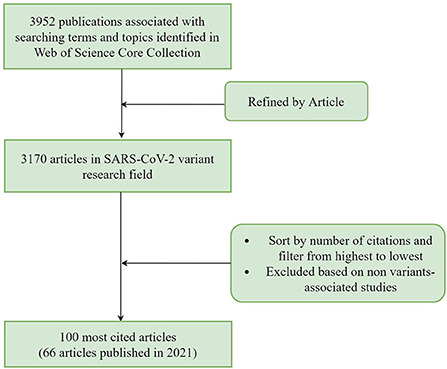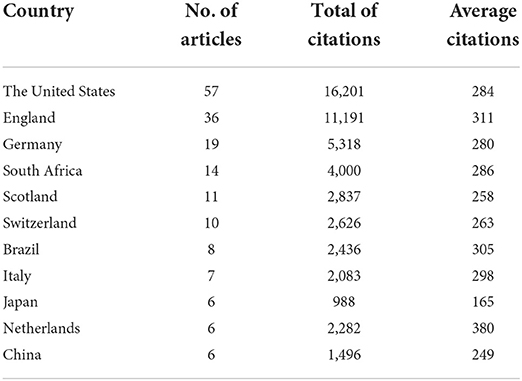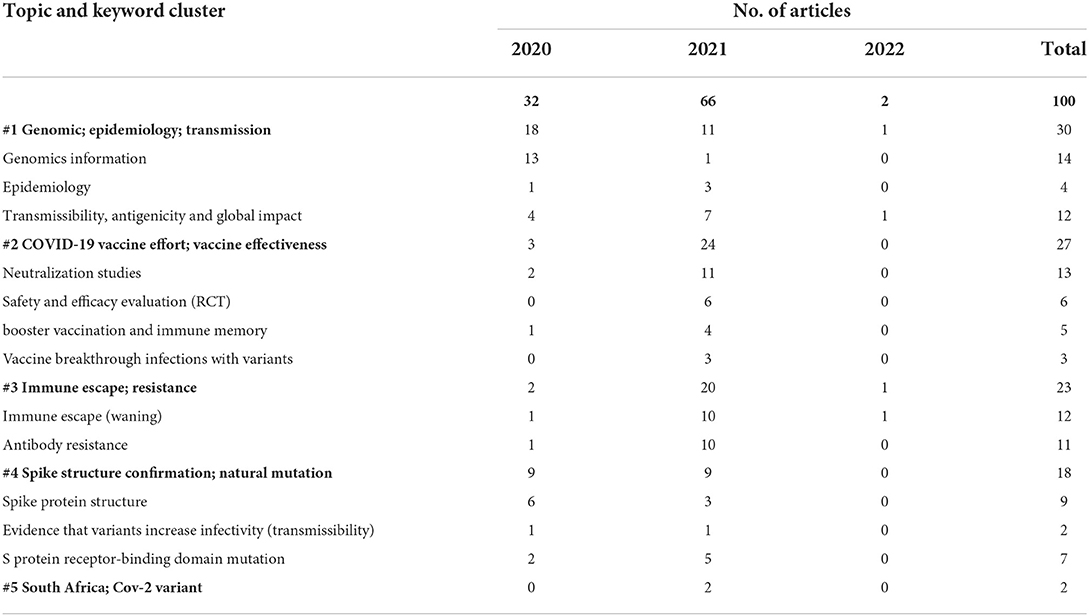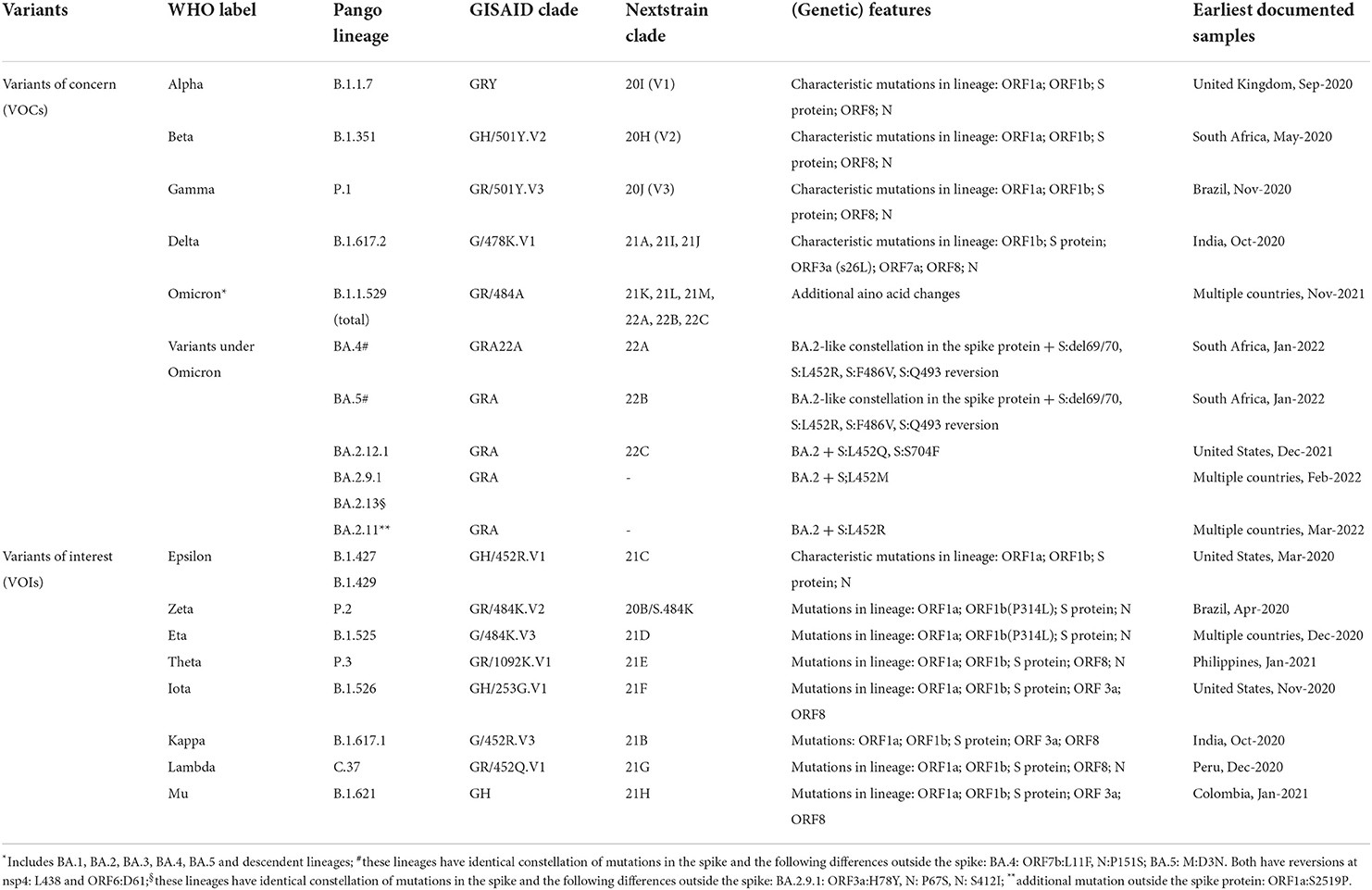- Department of Health Management, Aerospace Center Hospital, Beijing, China
Background: The emergence of severe acute respiratory syndrome coronavirus 2 (SARS-CoV-2) variants with mutations in the spike protein has risen concerns about the efficacy of infection- or vaccine-induced antibodies and has posed a serious threat to global public health, education, travel and economy. Few studies have described the detailed characterizations of highly cited articles on SARS-CoV-2 variants.
Objective: To identify and characterize the 100 most-cited articles in SARS-CoV-2 variants research.
Design and methods: Articles published recently were extracted from the web of science core collection database using a query based on MeSH terms and topics of SARS-CoV-2 and variants. Characteristics of the 100 most-cited articles were analyzed via the following parameters: publication number over year, number of citations, type of articles, authors, journal, journal impact factor, country, and topics covered in articles. In addition, clinical trials in these articles were also analyzed.
Results: The majority of articles (66%) were published in 2021. Number of citations of the 100 most cited articles ranged from 1720 to 75 (median: 178.5). Mutations in the S protein such as D614G mutation and the B.1.1.7 (UK) and B.1.351 (South Africa) were the dominant variants in the 100 most cited articles. The United States, the United Kingdom, and South Africa had the strongest collaboration in the contribution of publication. Science, Cell, Nature and New England Journal of Medicine were mostly cited and the main direction in these top journals were vaccine neutralizing tests and efficacy evaluation studies. Response of antibody neutralization tests against variants was always weakened due to the presence of variants but the results of clinical trials were encouraging. Genomics information, spike protein structure confirmation and neutralization studies evaluating antibody resistance were highly represented in the 100 most cited articles in SARS-CoV-2 variants literature.
Conclusions and relevance: Altogether, genomic information, epidemiology, immune neutralization, and vaccine efficacy studies of COVID-19 variants are the main research orientations in these articles and relevant results have been published in influential journals. Given the continuous evolution of the SARS-CoV-2 and the constant development in our understanding of the impact of variants, current working strategies and measures may be periodically adjusted.
Introduction
Severe acute respiratory syndrome coronavirus 2 (SARS-CoV-2), the virus that causes COVID-19, experiences changes in gene structure at any time (1). So far, this pandemic has severely threatened global public health. The best way to prevent and slow down transmission is to be well-informed about the disease and how the virus spreads. However, the emergence of the new variants brings big challenges to the therapeutic and preventive strategies of COVID-19 (2–5). The World Health Organization recently reported that there were 14.9 million excess deaths due to SARS-CoV-2 pandemic in 2020 and 2021 (https://www.who.int/zh). In the past few months, researchers identified that these emerging variants were caused by genome mutations and were emerging rapidly, as exemplified by the B.1.1.7 (United Kingdom), B.1.351 (South Africa), and P.1 (Brazil) lineages termed variants of concern/interest (VOC/I) because of the greater risk they pose due to possible enhanced transmissibility and infectivity, immune response evasion, treatment failure, and reduced vaccine efficacy (6–8). Rapid development and evaluation of medical countermeasures against new emerging SARS-CoV-2 variants are urgently needed.
Ever since the initial discovery and identification, more than three thousand studies on this domain have already appeared in the scientific literature. Published articles covered a wide range of topics, including but not limited to, cell biology, biochemistry molecular biology, medicine general internal, microbiology, virology, and infectious diseases. Concurrently, these articles also revealed a wide range of dominant countries, journals, institutions, and authors that have made certain contributions in this field. Given the broad range of interests covered in these published works, it is of great necessity for scientific investigators to determine the precise study direction and relative challenges. Characterization of high-quality studies can aid researchers to tailor their study orientations and pursuit to associated interests.
Bibliometric science is mainly composed of citation analysis which is the source of impact factors (9). Publications with high citation counts are identified as core to a specific field. Therefore, highly cited articles can provide key information about research trends and scientific advances in a given field (10). To our best knowledge, few studies have reported important characterizations about the top 100 cited studies on SARS-CoV-2 variants. Our study did not seek to determine the types of studies being published; rather, we sought to determine the characteristics of highly cited articles.
Here, we aimed to identify the 100 most cited articles focused on SARS-CoV-2 variants and to characterize these articles.
Methods
Articles search and selection
On May 24, 2022, we generated a series of studies related to SARS-CoV-2 variants by utilizing the Web of Science Core Collection database. We used the following search terms and topics extracted from Medical Subject Headings (MeSH) to retrieve publications in the database: (TS = (SARS Coronavirus 2 OR 2019 Novel Coronavirus OR SARS-CoV-2 Virus OR 2019-nCoV OR Wuhan Coronavirus OR COVID19 Virus)) AND TS = (variant OR variants). Next, we selected “Articles” for the file type and the publication period from January 1, 2020 to May 24, 2022 for the search and obtained 3,170 original articles. Next, we sorted these articles in descending order of citations and checked whether they were related to the SARS-CoV-2 variant. Through this flow (Figure 1), we finalized the top 100 most cited articles on SARS-CoV-2 variants.
Two reviewers (Zhang and He) performed independent article identification and analysis, and a third senior reviewer (Ma) reassessed the results and discussed with them until a consensus was reached.
A SARS-CoV-2 variant article was defined as any research primarily focusing on emerging variants genomic information and epidemiology, special structure confirmation, vaccine design and development, randomized controlled trials on safety and efficacy of vaccine and animal studies about neutralizing antibody tests. Articles unrelated to the SARS-CoV-2 variant were excluded.
Data extraction and analysis
All of the 100 most cited articles were available online in the MEDLINE database. Every article was reviewed for retrieval of the publication year, journal title, journal impact factor, first author, number of citations (total citations), citations over year, type of article (basic research, randomized controlled trial or cross-sectional study), country and main topics covered in the articles. VOS viewer (Leiden University, Leiden, The Netherlands, version 1.6.17), a free JAVA-based software for bibliometric mapping developed by Ludo Waltman, and CiteSpace (version 5.8.R3), a visibility tool created by Prof. Chaomei Chen, were used for data visualization of co-authorship, co-citation, and co-occurrence analysis. Co-cited references (journals, authors) are two (or more) references (journals, authors) cited by one or more articles simultaneously (11, 12). Clustering analysis of the co-citation results can indicate the research categories and directions. In addition, we used co-occurrence analysis (also known as keyword analysis) to cluster keywords from different studies to represent and predict research hotspots in the field (11).
Statistical analysis
We used SPSS (version 26.0, IBM, Armonk, NY, USA) to describe the data distribution and analyze the correlation between JIF (journal impact factor) and CIF (number of citations/impact factor) ratio. Kolmogorov-Smirnov test was used to test the normality of continuous data. Continuous variables tested for normality were presented as the means and SD, otherwise as the median (interquartile range, IQR). P < 0.01 was set as statistical significance.
Results
Sixty-six of the 100 most cited articles were published in 2021. A total of 36 countries participated in the publication of the 100 most cited articles. The majority of the publications were contributed by the United States (n = 57), distantly followed by United Kingdom (n = 36), Germany (n = 19) and South Africa (n = 14) (Table 1). Coauthor ship analysis of countries showed the strongest collaboration between the United States, the United Kingdom, and South Africa (Figure 2). The highly cited articles were published in 33 journals, led by Nature (n = 14) and followed by Cell (n = 13), Science (n = 13), Nature Medicine (n = 10) and New England Journal of Medicine (n = 10) (Table 2). The top 15 institutions and study categories of total number of publications were presented in Figure 3.
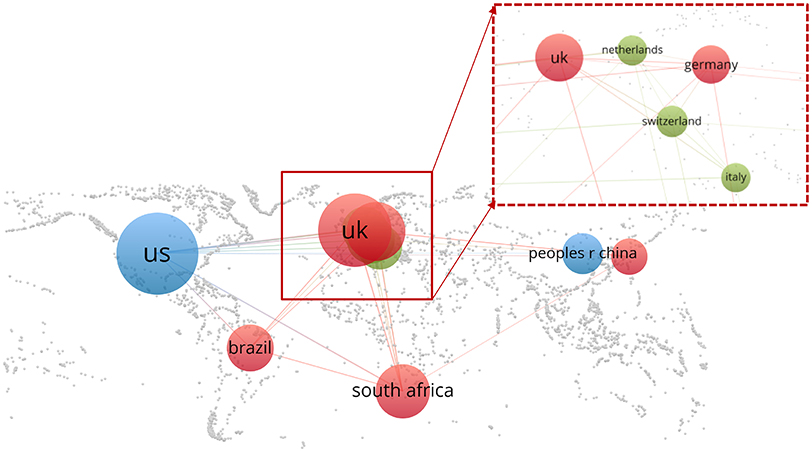
Figure 2. Country collaboration network on SARS-CoV-2 variants. The gray section indicates the national geographic border information.

Table 2. Journals in which two or more of the 100 most-cited SARS-CoV-2 variant articles were published.
The number of citations of the 100 most cited articles ranged from 1,720 to 75 (median: 178.5). All of the articles were published in 33 different journals and contributed by 2,129 authors, with an overall 26,153 total citations (10,221 citations in 2020, 15,757 citations in 2021, 175 citations in 2022). Characterization of the top 20 highly cited articles in SARS-CoV-2 variants and their number of citations over years were presented in Table 3 (complete features of 100 top-cited articles were shown in Supplementary Table 1). The top-ranking article of total citations conducted in 2020 by Korber et al. (13) dynamically tracked structural and biological changes in SARS-CoV-2 spike of variants based on regular updates from the GISAID SARS-CoV-2 sequence database and revealed that the spike D614G amino acid change (mutations) was associated with potentially higher viral loads in COVID-19 patients and can increase the frequency and global distribution making the variant carrying the D614G spike mutation became the globally dominant form of SARS-CoV-2.
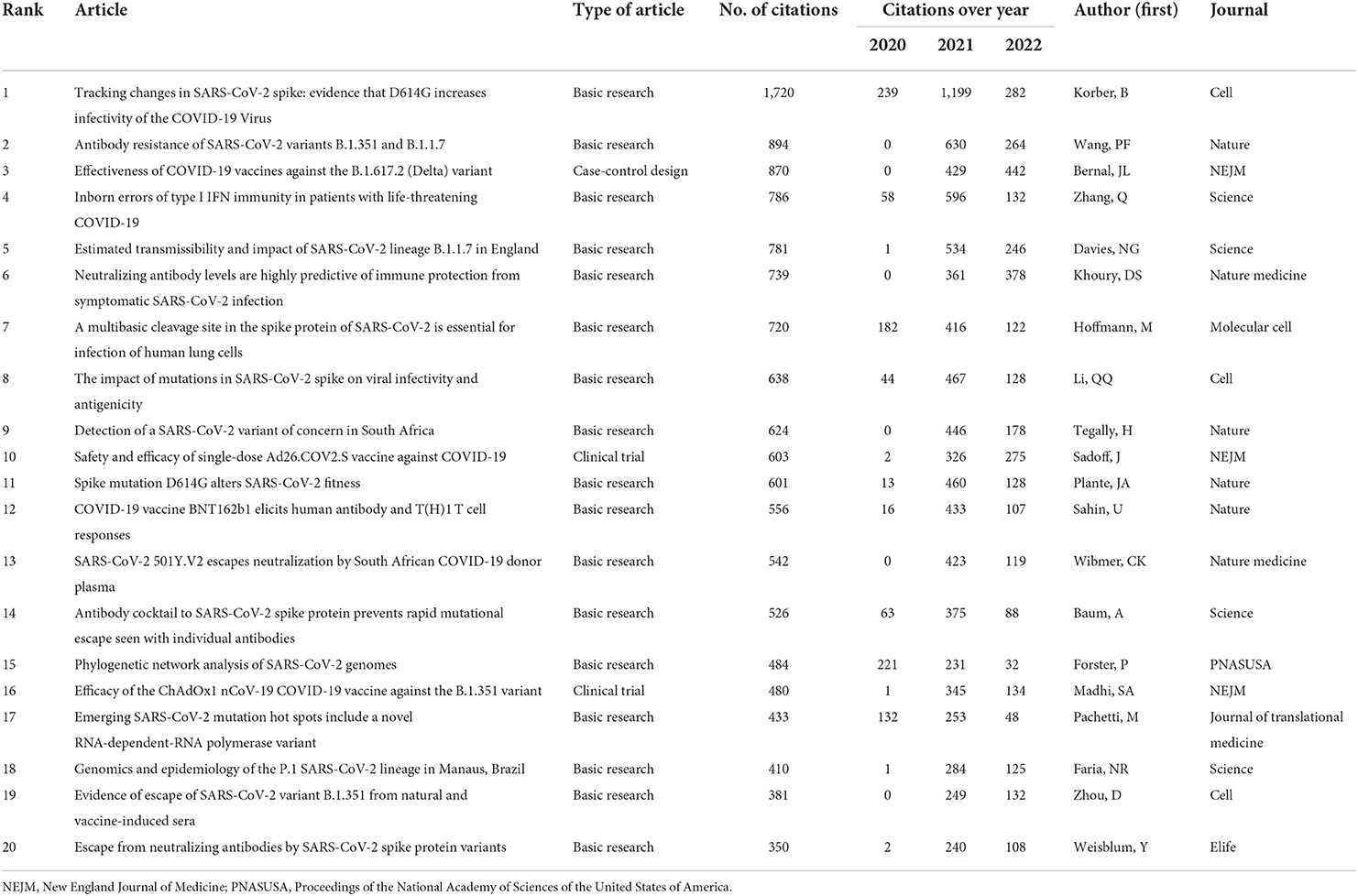
Table 3. The 20 most-cited SARS-CoV-2 variant articles ranked in order of the number of citations received.
Medians (interquartile range, IQR) of the JIF and CIF ratio were 47.728 (35.043) and 5.796 (9.382), respectively. Bivariate correlation analysis (Spearman) demonstrated a significant negative correlation between JIF and CIF ratio (correlation coefficient = −0.677, p = 0.000). We further present the top 20 articles in order of CIF from highest to lowest in Supplementary Table 2. The sources of articles and journal impact factors were also summarized in the table.
The most frequently co-cited journal mainly included Science, Cell, Nature and New England Journal of Medicine and most attention in these top journals has been paid to the topics of SARS-CoV-2 escape and neutralizing (Figure 4). The top 5 most frequently co-cited references involved Polack et al. (14), Korber et al. (13), Hoffmann et al. (15), Baum et al. (16), and Rambaut et al. (17). Clustering analysis based on research directions and detailed characterizations of co-cited references were summarized in Figure 5. Accordingly, Polack and Hoffmann had the most co-citations in this domain and the correlation between clustering cores of the most frequently co-cited authors was presented in Figure 6.
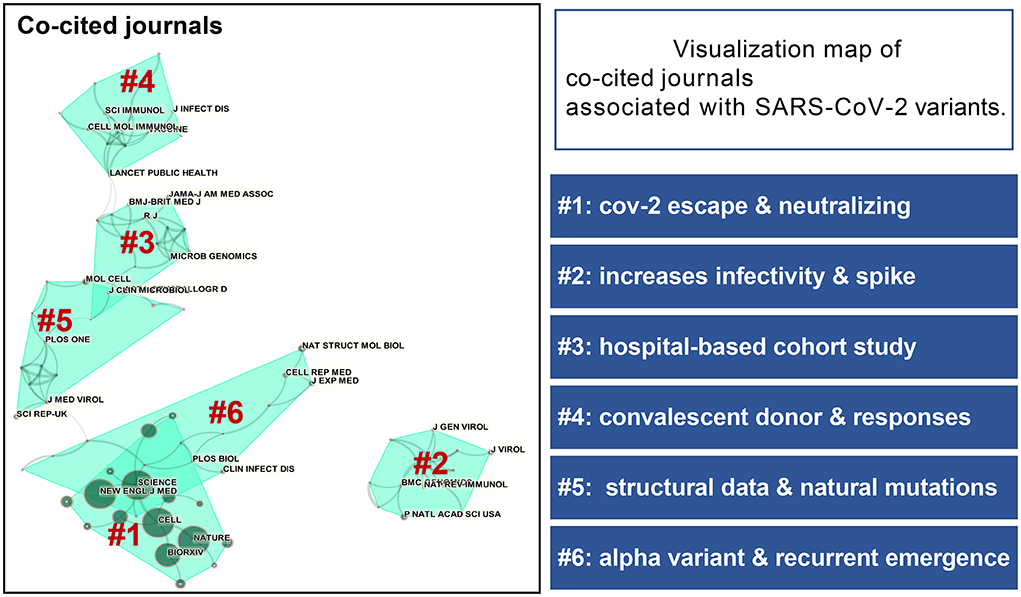
Figure 4. Visualization map of co-cited journals associated with SARS-CoV-2 variants and corresponding clusters based on research direction. The size of the circles indicates the number of co-citations. Lines between categories indicate cross-linkages between study directions.
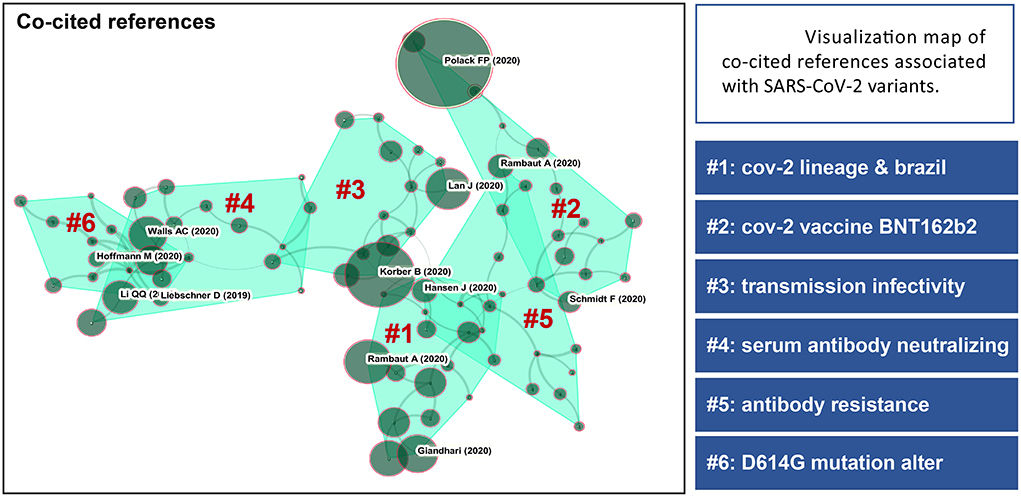
Figure 5. Visualization map of co-cited references associated with SARS-CoV-2 variants and corresponding clusters based on research direction. The size of the circles indicates the number of co-citations. Lines between categories indicate cross-linkages between study directions.
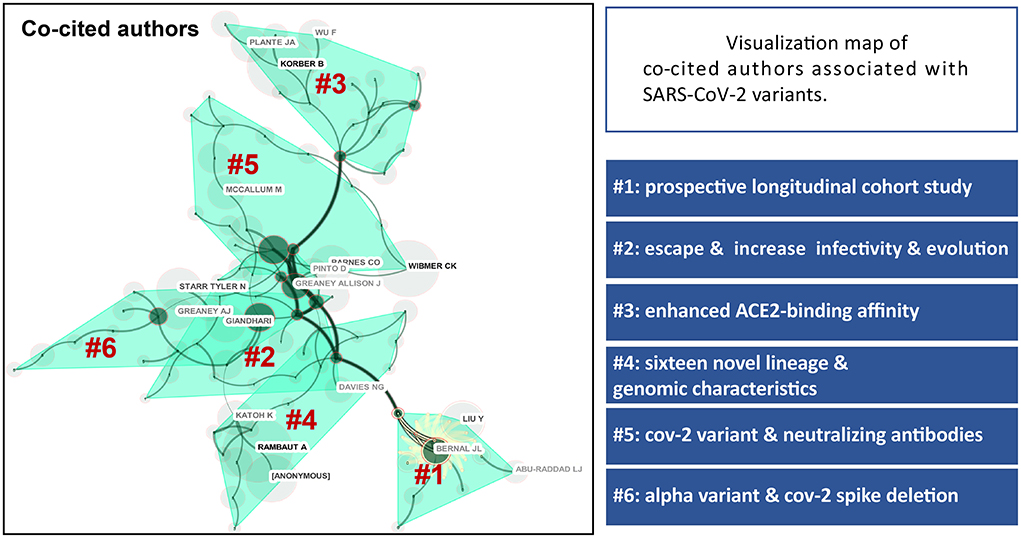
Figure 6. Visualization map of co-cited authors associated with SARS-CoV-2 variants and corresponding clusters based on research direction. The size of the circles indicates the number of co-citations. Lines between categories indicate cross-linkages between study directions.
Two hundred and thirty keywords were extracted from the 100 cited articles and were classified into five clusters: variants genomic analysis and epidemiology, COVID-19 vaccine effort, immune escape, spike structure confirmation, and South Africa variants studies (Figure 7). Furthermore, a review of articles showed that the most common topics were genomics information and transmissibility (n = 30), followed by neutralization studies (n = 27), antibody resistance (n = 23), and spike protein structure exploration (n = 18) (Table 4). Mutations in the S protein such as D614G mutation and the B.1.1.7 (alpha, UK) and B.1.351 (South Africa) were the dominant variants in these articles (Table 5).
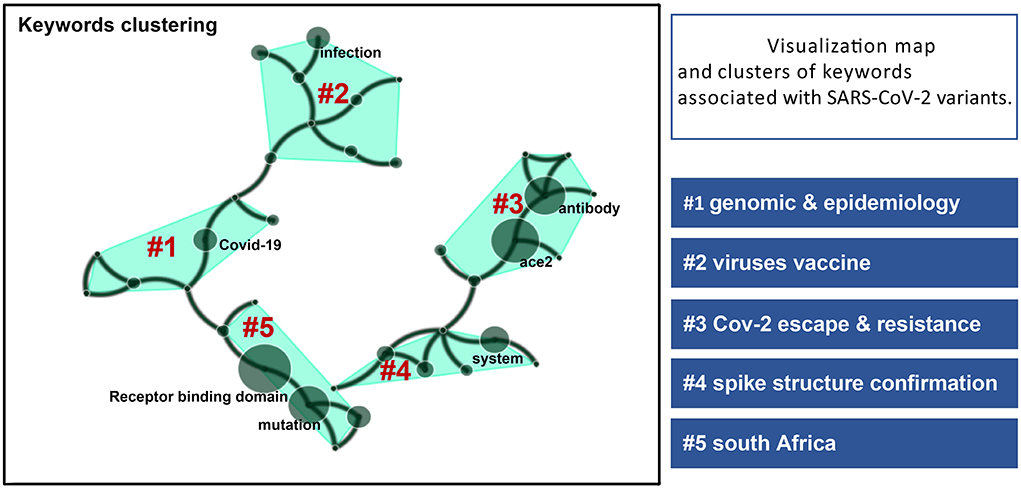
Figure 7. Visualization map and clusters of keywords associated with SARS-CoV-2 variants and corresponding clusters based on research direction. The size of the circles indicates the frequency of keyword occurrences.
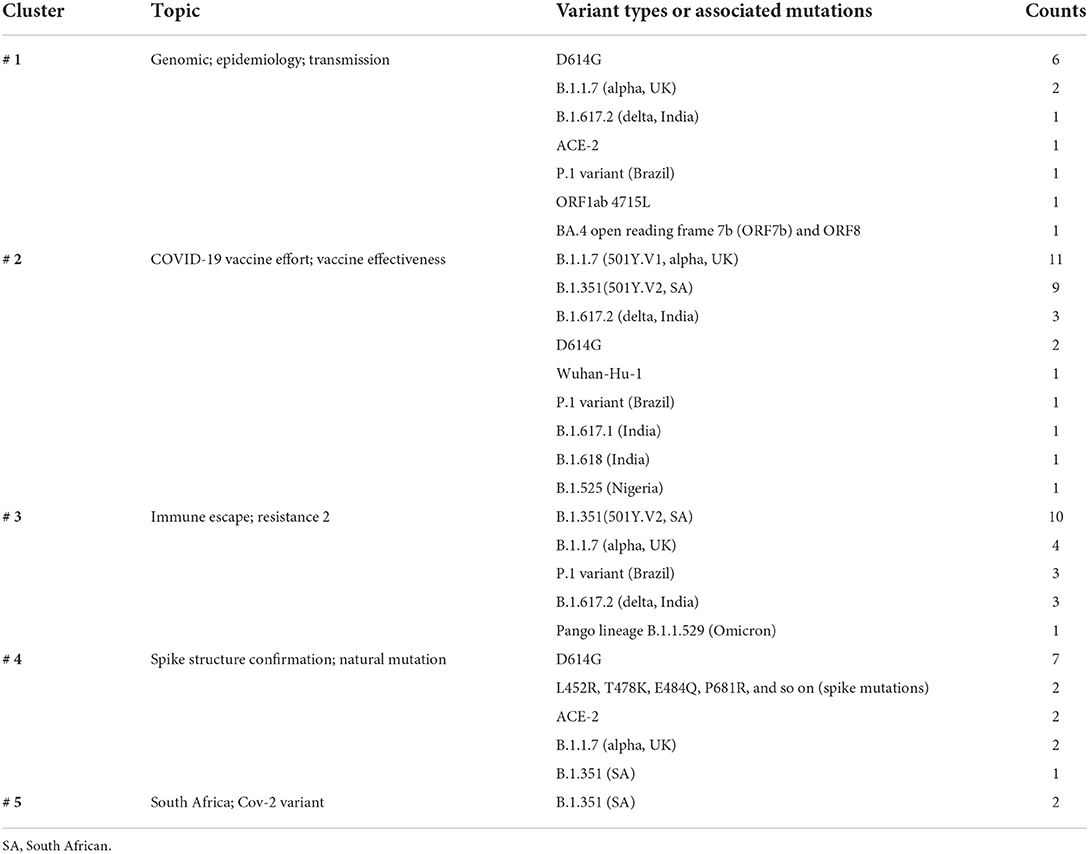
Table 5. Variant types or associated mutations and their occurrence frequencies in different topic clusters.
Six clinical trials were conducted to explore the efficacy and safety of existing vaccines against the dominant variants such as B.1.1.7 (United Kingdom), B.1.351 (South Africa) lineages. Variants lineages, number of subjects, vaccine types, main clinical measure and National Clinical Trial (NCT) number were summarized in Table 6. It is noteworthy that all randomized controlled trials were reported in 2021 and 5 of them were phase 3 trials. Median (range) of the number of patients with evidence of SARS-CoV-2 variants infection and durations in these trials were 35 (8–520) persons and 28 (7–180) days, respectively. It is noteworthy that the primary clinical measures of 4 of 6 RCTs were mainly concentrated on the efficacy evaluation of a two-dose regimen (or booster injection) of vaccines against B.1.1.7 variants or B.1.351 variants. Most of their results were encouraging in addition to the clinical trial conducted by Madhi et al. (19) concluded with the poor protection efficacy of a two-dose regimen of the ChAdOx1 nCoV-19 vaccine (AZD1222) against mild-to-moderate COVID-19 due to the B.1.351 variant.
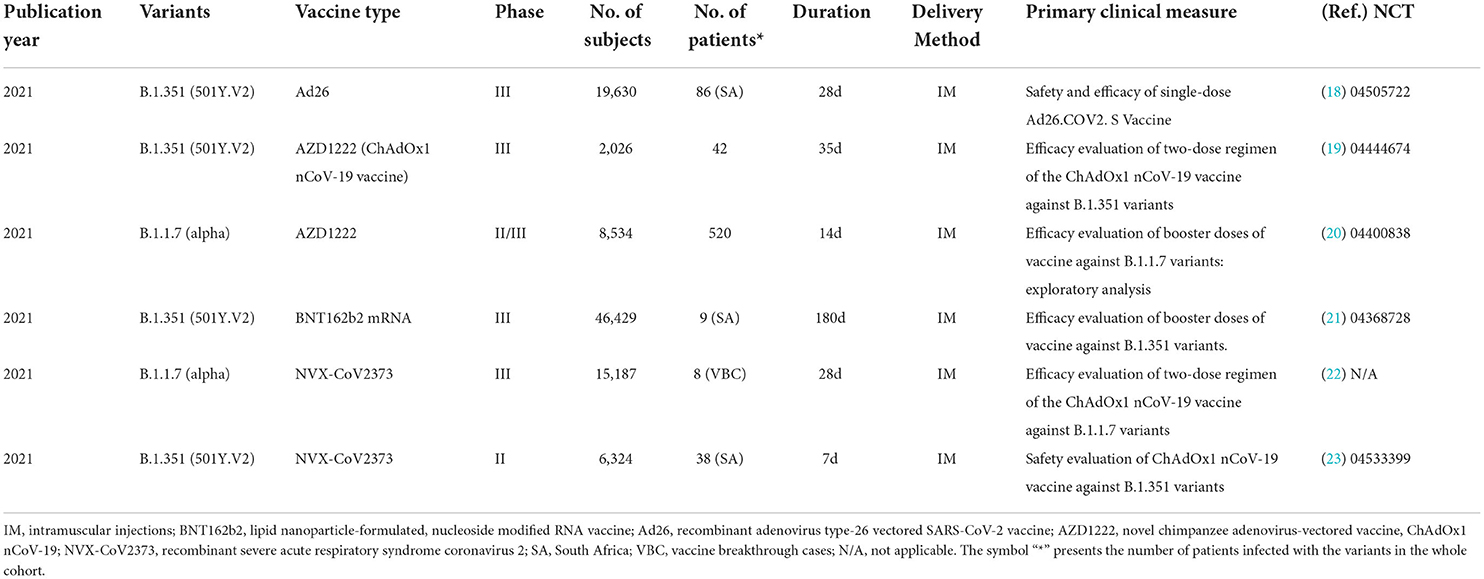
Table 6. Influential clinical trials investigating the safety and efficacy of diverse vaccines against SARS-CoV-2 variant.
Discussion
Here, we firstly utilized citation analysis in an attempt to characterize the most cited articles in the SARS-CoV-2 variants field. The number of citations an article has is a valuable measure of its impact on the topics it addresses and this number has become a symbol for evaluating authors and journals (24). Understanding and identification of the features of the 100 most cited articles in SARS-CoV-2 variants domain are of great interest to scientific researchers and the public. First, epidemiologists and infectious disease researchers would find clear study orientations and current challenges that they must face thereby adjusting the therapeutic measures for emerging variants. Furthermore, with the aid of information that our study provides, policymakers also can precisely formulate epidemic prevention and control and variant-associated policies. Third, the public can get research and dissemination of current variants through our studies, which might be helpful for compliance with preventive measures and policies. Finally, our results also can be deemed as a reference for journal editors to evaluate associated scientific works submitted for publication.
During late 2020, the emergence of variants that posed an increased risk to global public health prompted the characterization of specific variants of interest (VOIs) and variants of concern (VOCs). These highlighted the importance of tracking the emergence of mutations in variants genome that impact virulence, enhanced transmissibility, and immune and neutralizing antibody resistance. Therefore, identification and description of genomics information and biological behavior of emerging variants were the working focus in the early works of scientists from diverse research institutions. This trend accordingly promoted the public to think about whether neutralizing antibody responses induced by COVID-19 or current diverse vaccines remain effective. Few phase 1/2 and relatively more phase 3 clinical trials in the 100 most cited articles also explain the increased amount of attention on the vaccine efficacy against variants. Although almost 23% of studies reported the phenomenon of immune escape and poor serum antibodies response, most of the results of RCTs were encouraging. More and large clinical trials are ongoing.
The results of the Spearman correlation and the data distribution of the JIF and CIF ratio in the table demonstrated that many journals with low-impact factors that might be less accessed by the scientific community during a fast-paced pandemic were worthy and very reliable. The top-ranked articles according to the CIF ratio focus more on basic research rather than clinical trials indicating the importance of these articles in guiding clinical decision-making and public health management. Scientific workers and the public should pay more attention to these articles. And based on this, we call for future bibliometric analyses to also adopt this method of data analysis to obtain more valuable conclusions.
In this study, we also summarized the variant types mentioned in the 100 most cited articles and matched them with the topic clusters (Table 6). Mutations in the S protein such as D614G mutation were the dominant variant form in the epidemiology and transmission studies showing that the S protein may be key viral transmission. Identification and description of the spike (S) protein variant D614G are also the hot spots in highly cited articles. The increased infectivity of D614G variants could be associated with the angiotensin-converting enzyme-2 (ACE2) receptor that increased entry efficiency (25). This mutation may be associated with the increase in virulence (or transmissibility) (26) or decrease in effectiveness of public health and social measures. Furthermore, in the vaccine effectiveness and immune escape studies, the B.1.1.7 (501Y.V1, alpha, UK) and B.1.351 (501Y.V2, South Africa) were the most-studied variants. Both of them belong to the previously circulating variants of concern (VOCs) characterized by immune escape and neutralizing antibody resistance (7).
Differentiation and characterization of diverse current variants based on their biological behaviors can aid health workers to periodically adjust the social measures or available diagnostics, vaccines, therapeutics. Variants can be categorized according to the working definition of WHO to their features, mainly including two categories: variants of concern (VOCs) and variants of interest (VOIs). VOCs have been demonstrated to be associated with one or more of the following changes at a degree of global public health significance: increase in transmissibility (virulence), detrimental change in COVID-19 epidemiology, or decrease in the effectiveness of public health and social measures. While VOIs feature the genetic changes that are predicted or known to affect virus characteristics such as transmissibility, disease severity, immune escape, diagnostic or therapeutic escape. The current VOCs and VOIs were summarized in Table 7 based on their Pango lineage, GISAID clade (www.gisaid.org), and Nextstrain clade (http://nextstrain.org/ncov; https://outbreak.info/) information. We believe these pieces of frontier intelligence can provide a lot of information on the current variants and the influence their pose on global health. Systematic approaches to provide a representative indication of the extent of transmission of SARS-CoV-2 variants based on the local context, and to detect unusual epidemiological events can be periodically done.
Limitations
This study has limitations. Relying on only citation analysis maybe not be a perfect approach to evaluating the quality of articles on a specific field. Factors that influence citations an article possess involve not only publication-quality but also other factors that are not accounted for in our study such as self-citation and obliteration by incorporation (27). Another limitation is that the searching terms we used are highly dependent on the NLM's Medical Subject Headings (MeSH), which may lead to incomplete retrieval of publications in SARS-CoV-2 variant domain. Third, the presence of the phenomenon of anonymity that cannot be settled currently in the co-cited analysis of authors maybe make the results controversial. Finally, the citation database bias. We used only the Web of Science database to calculate the number of citations of articles in the current study that might differ from other databases such as PubMed, Scopus, and Embase databases.
Conclusion
SARS-CoV-2 is evolving. Genomics information, spike protein structure confirmation and neutralization studies on the evaluation of antibody resistance were highly represented in the 100 most cited articles in SARS-CoV-2 variants literature. Mutations in the S protein such as D614G mutation and the B.1.1.7 (alpha, UK) and B.1.351 (South Africa) were the dominant variants in the 100 most cited articles. Generally speaking, the responses of vaccine-induced antibody binding and neutralization against the SARS-CoV-2 were weakened due to the presence of variants, but the results of clinical trials were encouraging. Differentiation and characterization of diverse current variants based on their biological behaviors can encourage authorities to strengthen surveillance and sequencing capacities and apply systematic approaches to control them. Given the continuous evolution of the SARS-CoV-2 and the constant development in our understanding of the impact of variants, current working strategies and measures may be periodically adjusted.
Data availability statement
The original contributions presented in the study are included in the article/Supplementary material, further inquiries can be directed to the corresponding author.
Author contributions
RM contributed to the study conception and design. YZ and MF performed material preparation, data collection, and analysis. YZ finished the first draft of the manuscript. YH and FL commented on previous versions of the manuscript. All authors read and approved the final manuscript.
Conflict of interest
The authors declare that the research was conducted in the absence of any commercial or financial relationships that could be construed as a potential conflict of interest.
Publisher's note
All claims expressed in this article are solely those of the authors and do not necessarily represent those of their affiliated organizations, or those of the publisher, the editors and the reviewers. Any product that may be evaluated in this article, or claim that may be made by its manufacturer, is not guaranteed or endorsed by the publisher.
Supplementary material
The Supplementary Material for this article can be found online at: https://www.frontiersin.org/articles/10.3389/fpubh.2022.966847/full#supplementary-material
References
1. Amicone M, Borges V, Alves MJ, Isidro J, Zé-Zé L, Duarte S, et al. Mutation rate of SARS-CoV-2 and emergence of mutators during experimental evolution. Evol Med Public Health. (2022) 10:142–55. doi: 10.1093/emph/eoac010
2. Deng X, Garcia-Knight MA, Khalid MM, Servellita V, Wang C, Morris MK, et al. Transmission, infectivity, and neutralization of a spike L452R SARS-CoV-2 variant. Cell. (2021) 184:3426–37.e3428. doi: 10.1016/j.cell.2021.04.025
3. Harvey WT, Carabelli AM, Jackson B, Gupta RK, Thomson EC, Harrison EM, et al. SARS-CoV-2 variants, spike mutations and immune escape. Nat Rev Microbiol. (2021) 19:409–24. doi: 10.1038/s41579-021-00573-0
4. Singh DD, Parveen A, Yadav DK. SARS-CoV-2: emergence of new variants and effectiveness of vaccines. Front Cell Infect Microbiol. (2021) 11:777212. doi: 10.3389/fcimb.2021.777212
5. Tao K, Tzou PL, Nouhin J, Gupta RK, de Oliveira T, Kosakovsky Pond SL, et al. The biological and clinical significance of emerging SARS-CoV-2 variants. Nat Rev Genet. (2021) 22:757–73. doi: 10.1038/s41576-021-00408-x
6. Dejnirattisai W, Zhou D, Supasa P, Liu C, Mentzer AJ, Ginn HM, et al. Antibody evasion by the P.1 strain of SARS-CoV-2. Cell. (2021) 184:2939–54.e2939. doi: 10.1016/j.cell.2021.03.055
7. Geers D, Shamier MC, Bogers S, den Hartog G, Gommers L, Nieuwkoop NN, et al. SARS-CoV-2 variants of concern partially escape humoral but not T-cell responses in COVID-19 convalescent donors and vaccinees. Sci Immunol. (2021). doi: 10.1126/sciimmunol.abj1750
8. Supasa P, Zhou D, Dejnirattisai W, Liu C, Mentzer AJ, Ginn HM, et al. Reduced neutralization of SARS-CoV-2 B.1.1.7 variant by convalescent and vaccine sera. Cell. (2021) 184:2201–11.e2207. doi: 10.1016/j.cell.2021.02.033
9. Shah SM, Ahmad T, Chen S, Yuting G, Liu X, Yuan Y. A bibliometric analysis of the one hundred most cited studies in psychosomatic research. Psychother Psychosom. (2021) 90:425–30. doi: 10.1159/000516185
10. Durieux V, Gevenois PA. Bibliometric indicators: quality measurements of scientific publication. Radiology. (2010) 255:342–51. doi: 10.1148/radiol.09090626
11. Wang K, Xing D, Dong S, Lin J. The global state of research in nonsurgical treatment of knee osteoarthritis: a bibliometric and visualized study. BMC Musculoskelet Disord. (2019) 20:407. doi: 10.1186/s12891-019-2804-9
12. Tang F, Dai WB, Li XL, Turghun D, Huang H, Fan YQ. Publication trends and hot spots in femoroacetabular impingement research: a 20-year bibliometric analysis. J Arthroplasty. (2021) 36:2698–707. doi: 10.1016/j.arth.2021.03.019
13. Korber B, Fischer WM, Gnanakaran S, Yoon H, Theiler J, Abfalterer W, et al. Tracking changes in SARS-CoV-2 spike: evidence that D614G increases infectivity of the COVID-19 virus. Cell. (2020) 182:812–27.e819. doi: 10.1016/j.cell.2020.06.043
14. Polack FP, Thomas SJ, Kitchin N, Absalon J, Gurtman A, Lockhart S, et al. Safety and efficacy of the BNT162b2 mRNA COVID-19 vaccine. N Engl J Med. (2020) 383:2603–15. doi: 10.1056/NEJMoa2034577
15. Hoffmann M, Kleine-Weber H, Schroeder S, Krüger N, Herrler T, Erichsen S, et al. SARS-CoV-2 cell entry depends on ACE2 and TMPRSS2 and is blocked by a clinically proven protease inhibitor. Cell. (2020) 181:271–80.e278. doi: 10.1016/j.cell.2020.02.052
16. Baum A, Fulton BO, Wloga E, Copin R, Pascal KE, Russo V, et al. Antibody cocktail to SARS-CoV-2 spike protein prevents rapid mutational escape seen with individual antibodies. Science. (2020) 369:1014–8. doi: 10.1126/science.abd0831
17. Rambaut A, Holmes EC, O'Toole Á, Hill V, McCrone JT, Ruis C, et al. A dynamic nomenclature proposal for SARS-CoV-2 lineages to assist genomic epidemiology. Nat Microbiol. (2020) 5:1403–7. doi: 10.1038/s41564-020-0770-5
18. Sadoff J, Gray G, Vandebosch A, Cárdenas V, Shukarev G, Grinsztejn B, et al. Safety and efficacy of single-dose Ad26.COV2.S vaccine against COVID-19. N Engl J Med. (2021) 384:2187–201. doi: 10.1056/NEJMoa2101544
19. Madhi SA, Baillie V, Cutland CL, Voysey M, Koen AL, Fairlie L, et al. Efficacy of the ChAdOx1 nCoV-19 COVID-19 Vaccine against the B.1.351 Variant. N Engl J Med. (2021) 384:1885–98. doi: 10.1056/NEJMoa2102214
20. Emary KRW, Golubchik T, Aley PK, Ariani CV, Angus B, Bibi S, et al. Efficacy of ChAdOx1 nCoV-19 (AZD1222) vaccine against SARS-CoV-2 variant of concern 202012/01 (B.1.1.7): an exploratory analysis of a randomised controlled trial. Lancet. (2021) 397:1351–62. doi: 10.1016/S0140-6736(21)00628-0
21. Thomas SJ, Moreira ED Jr, Kitchin N, Absalon J, Gurtman A, Lockhart S, et al. Safety and efficacy of the BNT162b2 mRNA COVID-19 vaccine through 6 months. N Engl J Med. (2021) 385:1761–73. doi: 10.1056/NEJMoa2110345
22. Heath PT, Galiza EP, Baxter DN, Boffito M, Browne D, Burns F, et al. Safety and efficacy of NVX-CoV2373 COVID-19 vaccine. N Engl J Med. (2021) 385:1172–83. doi: 10.1056/NEJMoa2107659
23. Shinde V, Bhikha S, Hoosain Z, Archary M, Bhorat Q, Fairlie L, et al. Efficacy of NVX-CoV2373 COVID-19 Vaccine against the B.1.351 Variant. N Engl J Med. (2021) 384:1899–909. doi: 10.1056/NEJMoa2103055
24. Garfield E. Citation analysis as a tool in journal evaluation. Science. (1972) 178:471–9. doi: 10.1126/science.178.4060.471
25. Ozono S, Zhang Y, Ode H, Sano K, Tan TS, Imai K, et al. SARS-CoV-2 D614G spike mutation increases entry efficiency with enhanced ACE2-binding affinity. Nat Commun. (2021) 12:848. doi: 10.1038/s41467-021-21118-2
26. Yurkovetskiy L, Wang X, Pascal KE, Tomkins-Tinch C, Nyalile TP, Wang Y, et al. Structural and functional analysis of the D614G SARS-CoV-2 spike protein variant. Cell. (2020) 183:739–51.e738. doi: 10.1016/j.cell.2020.09.032
Keywords: SARS-CoV-2, infection, variant, mutation, bibliometric analysis, public health
Citation: Zhang Y, Feng M, He Y, Liu F and Ma R (2022) A bibliometric analysis of the 100 most cited articles describing SARS-CoV-2 variants. Front. Public Health 10:966847. doi: 10.3389/fpubh.2022.966847
Received: 15 June 2022; Accepted: 12 August 2022;
Published: 26 August 2022.
Edited by:
Daniele Mercatelli, University of Bologna, ItalyReviewed by:
Federico Manuel Giorgi, University of Bologna, ItalyPeter Kokol, University of Maribor, Slovenia
Daniela Dalla Gasperina, University of Insubria, Italy
Copyright © 2022 Zhang, Feng, He, Liu and Ma. This is an open-access article distributed under the terms of the Creative Commons Attribution License (CC BY). The use, distribution or reproduction in other forums is permitted, provided the original author(s) and the copyright owner(s) are credited and that the original publication in this journal is cited, in accordance with accepted academic practice. No use, distribution or reproduction is permitted which does not comply with these terms.
*Correspondence: Rui Ma, amtnbGI3MjFAMTYzLmNvbQ==
 Yahui Zhang
Yahui Zhang Meijing Feng
Meijing Feng Yongmei He
Yongmei He Fangming Liu
Fangming Liu Rui Ma
Rui Ma